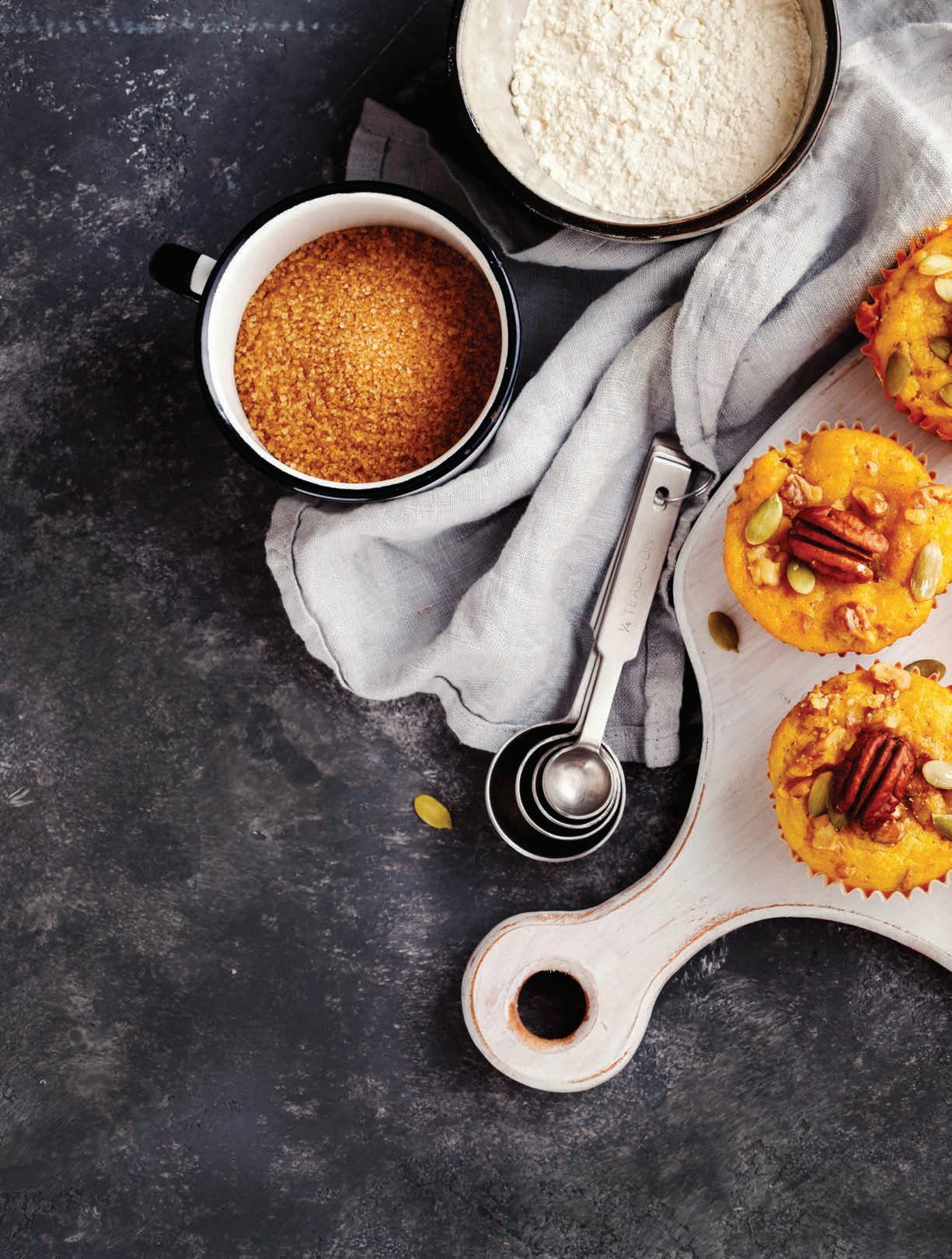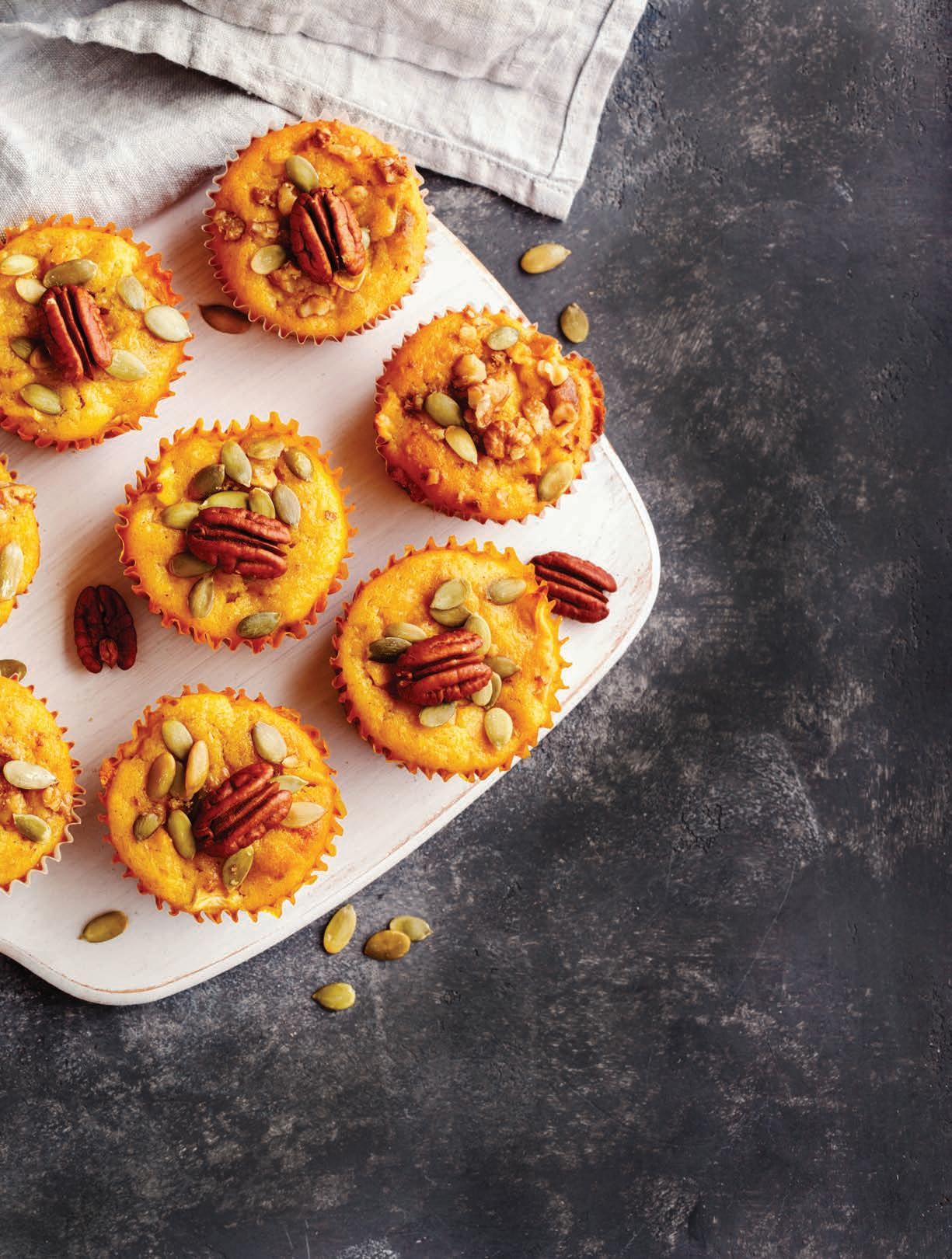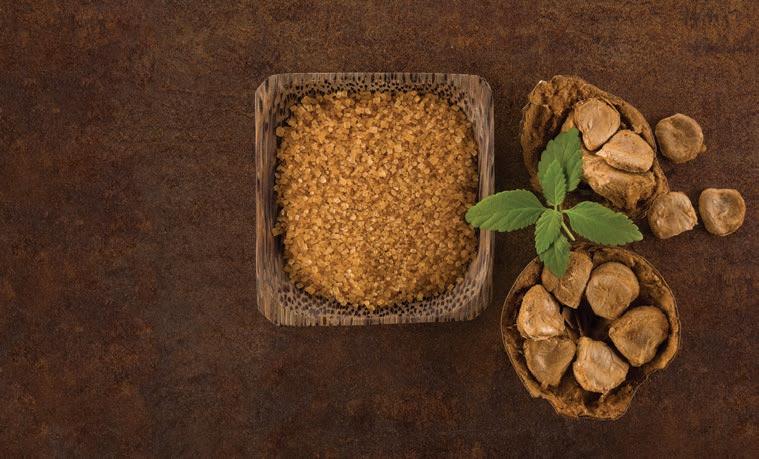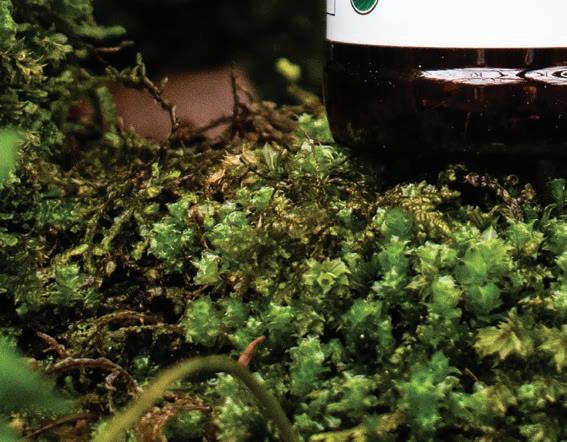
19 minute read
BETTER Zzzzs
Keys to Better Zzzzs
BY MARY ANN O’DELL, MS, RDN
Advertisement
GETTING ENOUGH SLEEP IS IMPORTANT for physical and mental recovery each day. Lack of good quality sleep can result in fatigue, mood swings, stress, and increased risk for illness or chronic disease. Here are 5 keys to help you get better sleep.
NAP SMART
If you have had trouble sleeping or have a change in work shift, a short nap during the day may help. Research suggests short naps may help reduce fatigue and increase productivity at work. But keep the nap short—just 10–20 minutes—and take it early in the afternoon to avoid affecting nighttime rest.
MANAGE STRESS
Stress is a common contributor to insomnia and sleep disturbance. Manage stress naturally by supporting nerve health with B vitamins. Sip on herbal tea, such as passionflower or chamomile, to keep nerves calm. Try yoga or deep breathing exercises in the evening to calm the body and mind.
CREATE COMFORT
Turn off your devices and take a nice soak in a hot mineral salt bath to relax your body and soothe any aches and pains. A deficiency of magnesium is associated with insomnia and anxiety, so maintaining magnesium status can help improve relaxation and rest. Try adding magnesium at night to enhance muscular relaxation and improve sleep. Make sure your bed and bedroom are comfortable—a cool, dark room helps support sleep.
TRY MELATONIN
Melatonin is a hormone naturally produced in the body that regulates the body’s circadian rhythm, its sleep and wake cycles. Melatonin levels decline significantly after the age of 40, which scientists believe may be responsible for sleep problems that increase with age. Melatonin can be very helpful for those who work night shift and sleep during the day. It is also beneficial for dealing with jet lag.
UTILIZE HERBS
Valerian has been shown in studies to help improve the quality of sleep, reduce the length of time it takes to fall asleep, and reduce the number of awakenings throughout the night. Valerian can be used by itself or in conjunction with herbal nervines that nourish and calm the nerves such as hops, passionflower, and skullcap. These act on the body naturally, without the unwanted side effects that are common with prescription and over-the-counter sleep medicines.
So with all that’s going on…who’s ready for a nap?
Paragon Plus™ Herbal E-Z Rest™
Supports rest and relaxation.* With a blend of valerian, hops, passionflower, chamomile, and skullcap. Enhanced with calcium and magnesium.
Paragon Plus™ Melatonin Dots 1 mg
May support rest and relaxation.* Melatonin is a hormone naturally produced by the body. 1 mg per sublingual tablet.
Keep your celebration sugar-free and cut down on the carbs this year with festive confections made with xylitol, monk fruit, stevia, and erythritol. BY LISA TURNER Sweet Treats

If you’re on a Keto or low-carb diet—or just generally appalled by the sugar content of most holiday treats—there’s a sweet solution: natural, sugar-free substitutes that let you indulge in cookies, pies, and cakes without upsetting blood sugar or blowing your daily carb count through the roof. Here’s a roundup of the four best sugar alternatives, plus recipes for low-carb, grain-free, no-sugar treats that can sweeten your celebration without sacrificing flavor.
Pumpkin-Pecan Muffins
Makes 12 muffins These muffins make an excellent dessert or holiday breakfast. We used a monk fruit 1:1 sweetener that’s combined with erythritol for a simple sugar swap. For garnish and texture, try adding pecan halves, chopped walnuts, and pepitas on top.

2½ cups almond flour 2 tsp. baking powder 2 tsp. ground cinnamon 2 tsp. ground ginger ½ tsp. ground cloves ½ tsp. ground nutmeg ½ tsp. salt ½ cup butter at room temperature ¾ cup monk fruit 1:1 sweetener 4 large eggs 1 cup pumpkin puree, unsweetened 2 tsp. vanilla extract ½ cup chopped pecans
1. Preheat oven to 350°F. Grease 12-cup muffin pan, or line with paper muffin cups. In medium bowl, whisk together almond flour, baking powder, cinnamon, ginger, cloves, nutmeg, and salt. 2. In standing mixer or large bowl using handheld mixer, beat butter and monk fruit sweetener until creamy and light, scraping down sides of mixing bowl as needed. Beat in eggs one at a time. Beat in pumpkin purée and vanilla. Stir dry ingredients into wet ingredients until well combined; stir in pecans. 3. Divide muffin mixture among muffin cups. Bake 25 minutes, until puffy and golden, and a tester inserted into muffins comes out clean. Remove from oven and let cool 10 minutes. Remove muffins from tins and serve immediately.
Per muffin: 270 cal; 8g prot; 24g total fat (7g sat fat); 10g carb; 80mg chol; 320mg sod; 4g fiber; 2g sugar
1. Xylitol. This sugar alcohol naturally occurs in small amounts in strawberries, raspberries, and other fruits and vegetables, and is most abundant in birch tree bark. It’s sold as a white crystalline powder that’s similar in appearance and sweetness to white sugar, but has 40 percent fewer calories and a very low glycemic index of 10 (compared to white sugar at 68). Because the body doesn’t metabolize xylitol as a sugar, it has no effect on insulin levels, and some studies show that it can also prevent tooth decay and possibly improve bone and tooth health. It may also control Candida and prevent ear infections.
Like other sugar alcohols, xylitol can cause bloating, gas, and flatulence, and may have a laxative effect in large quantities. Start small to let your body get used to it, and limit consumption to 50 grams per day. And while it’s completely safe for humans, xylitol is toxic to dogs, so keep it in a pooch-proof container, and don’t let pets sample your baked treats.
How to buy it. Though you can find birch-derived xylitol, which is more expensive, it’s often derived from corn, which can contain GMOs. Look for organic or non-GMO xylitol, and be sure it’s free of fillers or other additives.
How to use it. Unlike concentrated sweeteners, xylitol bakes well, adds bulk to recipes, and can be used as a 1:1 substitute for white sugar. To avoid any potential digestive distress, it’s best combined with a concentrated sweetener such as monk fruit or stevia. 2. Erythritol. Like xylitol, erythritol is a sugar alcohol that occurs naturally in grapes, pears, mushrooms, and other fruits and vegetables. Commercially, it’s made by fermenting glucose from corn, and has a clean, neutral flavor and color with a very low glycemic index of 1. Erythritol doesn’t impact blood sugar or insulin levels, and because it’s not metabolized by bacteria in the mouth, it won’t cause tooth decay and may even promote remineralization of teeth. Unlike other sugar alcohols, erythritol

Serves 4 For a vegan alternative, swap full-fat coconut milk for the heavy cream.
MOUSSE 3 large, very ripe avocados, halved and pitted ½ cup unsweetened cocoa powder ¾ cup heavy cream or coconut milk 2 tsp. peppermint extract ⅛ tsp. salt ¼–½ tsp. monk fruit extract or stevia extract, or to taste
WHIPPED CREAM ½ cup heavy whipping cream or 1 can full-fat coconut milk, refrigerated overnight Monk fruit extract or stevia extract to taste 2 Tbs. very finely minced fresh mint leaves or 1 tsp. peppermint extract
1. Scoop flesh out of avocado skins into food processor. Add cocoa powder, cream or coconut milk, peppermint extract, and salt. Purée until smooth and creamy. 2. Add monk fruit or stevia extract, and purée again to combine. Taste, and adjust sweetener and mint extract, if desired. Divide mousse among four parfait glasses or small dessert bowls. Chill 30 minutes to 1 hour. 3. While mousse is chilling, using a standing mixer or a hand mixer, whip heavy cream on medium-high speed until peaks form, 3–4 minutes. (If using coconut milk, open chilled can of coconut milk, and scoop hardened cream from the top; reserve remaining coconut milk for another use.) Sweeten to taste with monk fruit or stevia extract. Gently stir in minced fresh mint leaves or peppermint extract. 4. Remove chilled mousse from refrigerator and top each serving dish with whipped cream; serve immediately.
Per serving: 520 cal; 7g prot; 51g total fat (21g sat fat); 21g carb; 85mg chol; 105mg sod; 14g fiber; 3g sugar
Coconut Lemon Bars
Makes 16 bars These, cool, zesty lemon bars are sweetened with xylitol, which works well with citrus and is an easy 1-to-1 swap for sugar. If you’re concerned about digestive issues, use erythritol, or swap ¼ tsp. monk fruit or stevia for the ¼ cup of xylitol in the crust to lessen the impact. For a coconut-free variation, substitute almond flour for coconut flour in the filling, and swap coconut flakes with powdered erythritol sprinkled on top of the bars after baking.
3 large lemons 1 cup almond flour ¾ cup xylitol or erythritol, divided ½ tsp. salt ⅓ cup melted butter ¼ cup softened butter 6 large eggs ½ cup coconut flour ½ cup unsweetened shredded coconut
1. Preheat oven to 350°F. Line 8x8 glass baking dish with two sheets parchment paper, crisscrossing parchment to line bottom and both sides, and allowing edges to overhang by ½ inch. Zest and juice lemons, and set aside. 2. In medium bowl, whisk together almond flour, ¼ cup of xylitol or erythritol, and salt. Stir in melted butter and 2 Tbs. lemon zest, mixing until well combined. Press crust along bottom of prepared baking dish. 3. In standing mixer or a medium bowl using hand mixer, beat remaining xylitol and softened butter until light and creamy. Beat in eggs, one at a time. Add lemon juice, remaining lemon zest, and coconut flour, and beat until smooth. 4. Pour filling into crust and spread evenly, smoothing top. Bake 25 minutes. Sprinkle tops of bars with coconut, and bake 5–10 minutes more, until filling is set and coconut is lightly toasted. Remove from oven and let cool completely. Refrigerate 1–2 hours, until chilled. 5. Using parchment overhang, lift bars from pan and place on flat surface. Cut into 16 bars, and serve immediately.
Per serving: 190 cal; 5g prot; 14g total fat (7g sat fat); 14g carb; 90mg chol; 160mg sod; 3g fiber; 1g sugar
M k fruit heat- stable d c be ed in y kind of c king d baking.

is mostly absorbed into the bloodstream before it reaches the colon, and appears to resist fermentation by gut bacteria. So it’s less likely to cause digestive distress.
How to buy it. Because it’s made with corn, look for non-GMO or organic erythritol in powdered form. Some products contain added ingredients, such as oligosaccharides or stevia, to increase its sweetness; 100 percent erythritol products are also available.
How to use it. Erythritol can be used in baking or any kind of cooking. In general, use 1⅓ cups of erythritol for each cup of sugar. To improve flavor and minimize any possibility of digestive distress, combine it with other sweeteners such as monk fruit or stevia. 3. Stevia. Derived from a plant native to South America, stevia contain compounds called steviosides and rebaudiosides that are about 300 times sweeter than sugar. It’s calorie-free, and has no impact on blood sugar or insulin levels. Though some early research suggested that stevia could contribute to infertility and cancer, these studies have been debunked, and new studies suggest that compounds in stevia may actually protect against some types of cancer. Other studies show that stevia lowers insulin and glucose levels and may normalize cholesterol.
How to buy it. Though the raw, powdered herb is the most natural form, it has a bitter taste and slightly licorice flavor, and isn’t good for baking. Concentrated forms of stevia like Reb-A have a cleaner flavor and less aftertaste. Some stevia products contain bulking ingredients, including erythritol, dextrose, or maltodextrin, to make them easier to use. Make sure the form you buy is organic or non-GMO.
How to use it. While stevia is heat stable and is ideal in puddings, ice cream, or smoothies, it’s harder to use in baking because it lacks bulk. Combine it with erythritol or xylitol to add bulk, and use a ratio of about ½ teaspoon stevia for 1 cup of sugar. 4. M k fruit. This super-natural sweetener from the lo han guo plant, is made by crushing the fruit to extract its intensely sweet compounds called mogrosides. Monk fruit has a clean, sweet flavor, without the bitter aftertaste of stevia. But like stevia, it’s calorie-free and doesn’t impact blood sugar or insulin. Lo han guo has been used for thousands of years in traditional Chinese medicine, and some studies suggest that the plant has antibacterial activities and can fight oral bacteria and Candida.
How to buy it. You’ll find monk fruit in a wide variety of forms, from pure concentrates to powders that combine monk fruit with erythritol, dextrose, or maltodextrin for bulk. If you’re buying monk fruit mixed with other ingredients, look for organic or non-GMO versions.
How to use it. Monk fruit is heat stable and can be used in any kind of cooking and baking. Like stevia, it lacks bulk, so it’s best combined with erythritol or xylitol. Or use a powdered form that has added bulking agents. The amount you’ll use in recipes varies depending on what product you’re using; for pure monk fruit extracts, use 1 teaspoon to replace a cup of sugar.
10 WAYS TO CONQUER COLDS, FIGHT FLU, AND STAY HEALTHY THIS WINTER




BY LISA TURNER
Fever, body aches, sore throats, and coughs that last till spring—it’s that time of year again. But you don’t have to be miserable. Herbs, supplements, foods, and lifestyle practices can help you kick that sickness to the curb. Just try these sciencebased remedies that really work.
1Suck on some zinc. It can signifi cantly reduce the duration of colds and severity of symptoms. Taken within 24 hours after symptoms start, zinc lozenges can shorten the length of colds by up to three days and cut the duration of some symptoms, such as stuff y nose, by as much as 58 percent. While lozenges have the best immediate eff ect, zinc supplements may also support immunity and lower your risk of getting sick. To stop a cold in its tracks, take zinc lozenges as soon as symptoms appear. For longer-term protection, take zinc capsules or tablets. But avoid zinc nasal sprays and swabs—they’ve been linked with an irreversible loss of the sense of smell. 2Get more sunshine. When skin is exposed to sunlight, the body produces vitamin D, critical for healthy immune function. In cold, cloudy winter months, when you’re not out as much, you may need supplements, since low levels of vitamin D can make you more susceptible to colds and fl u. Epidemiologic studies show that high vitamin D levels are linked with a reduced risk of upper respiratory tract infections, and supplementing with vitamin D signifi cantly lowers risk of infection. In one study, vitamin D cut the risk of respiratory infection in half, especially in people who were defi cient. Look for vitamin D3 in gel caps or liquids for best absorption.
3Load up on echinacea. It’s rich in compounds that support the immune system by activating the body’s defense systems. Some studies show that echinacea can inhibit the flu virus, viral growth, and the secretion of pro-inflammatory compounds in the body. Studies on echinacea’s effects on colds are mixed, but some research suggests that it can inactivate certain respiratory bacteria, reverse inflammatory effects caused by these bacteria, and control symptoms. In some cases, echinacea may reduce the likelihood of getting a cold by 10–20 percent. Choose standardized echinacea tinctures for maximum absorption, or try echinacea capsules.

4Don’t forget “Indian
echinacea.” Andrographis, also called “Indian echinacea,” supports immune function and can both prevent sickness and significantly improve symptoms. Studies show that andrographis is twice as effective as a placebo at reducing respiratory tract infection symptoms (cough, sore throat, runny nose, fever), and can lessen the duration of illness. One review of 33 studies found that andrographis was significantly better than other herbal therapies at reducing symptoms of respiratory tract infections. Most studies used a product that combines andrographis with Siberian ginseng. Try andrographis capsules or tablets, or look for it in combination respiratory health formulas. 5Sauté some shiitakes. They’re rich in compounds called beta glucans that support immune function and protect against colds and flu. Add broccoli or kale—like other cruciferous vegetables, they support immune function—and carrots or other orange vegetables that can protect against infection. Include lots of garlic, which activates the body’s natural killer cells and reduces the severity of cold and flu symptoms. And sprinkle your stir-fry with nutritional yeast, which increases the body’s potential to defend against invading pathogens and can reduce infections by as much as 25 percent. If you don’t love mushrooms, try a supplement. Look for reishi,
maitake, lion’s mane, or cordyceps, or choose a blend formulated to support immune function.
6Boost your berries. Blueberries, blackberries, strawberries, and other berries are rich in polyphenols that support immune function and may protect against the fl u. Elderberry in particular is rich in antioxidant polyphenols that enhance immune cell activity and may block a virus’s ability to spread. Research shows that elderberry both inhibits the fl u virus and also reduces symptoms if you do get an infection. In one study of people who had the fl u, almost 47 percent of those who took an elderberry extract for three days had a complete resolution of their symptoms. In another study, elderberry extract cut duration of fl u symptoms in half. Look for syrups, lozenges, or eff ervescent tablets, and take as soon symptoms appear.
7Rest easy. A good night’s sleep protects immune function and can reduce your risk of colds and fl u. Part of the reason: the body releases chemicals during sleep that help regulate immune response and fi ght infection. Sleep also lowers stress, which can make you more susceptible to sickness. Quality is as important as quantity: one study found that people who slept less than seven hours a night were almost three times more likely to get a cold, and those who slept poorly were more than fi ve times more prone to colds. If you struggle to snooze, try melatonin, valerian, or kava kava, which have all been shown to improve quality of sleep.
8Get back to your roots. In herbal medicine, it’s thought that the healing compounds of many plants are more concentrated in the roots. Three to try:
Ginseng has a long history of use in traditional Chinese medicine for its immune-supportive eff ects. It helps protect against upper respiratory infections and some studies show that taking ginseng daily for 3–4 months during fl u season can signifi cantly decrease the risk of developing a cold or fl u and reduce the number of colds in a season. If you do get an infection, ginseng can reduce symptom severity, and duration. Choose standardized ginseng in tinctures or capsules, ideally organic, and look for a formula that’s been tested for purity.
Pelargonium, from a plant known as African geranium, has antiviral and antibacterial activities, and is eff ective in treating a number of respiratory conditions, including bronchitis, sinusitis, and the common cold. Other studies show pelargonium extract may inhibit infection by, and prevent the replication of, respiratory viruses. It’s sold under the brand name
BEAT THE BUGS
Terry Naturally Andrographis EP80 Extra Strength
Host Defense MycoSheild Immune Support Spray Quantum Health TheraZinc Lozenges Irwin Naturals Immuno-Shield with Elderberry. Nature’s Way Umcka Cold+Flu Umcka or as umckaloabo, in syrups, liquids, drink mixes, and tablets.
Turmeric, traditionally used in Ayurvedic medicine, is known for its ability to reduce infl ammation and support immune function. It also has antibacterial and antiviral properties, and can protect against viruses that cause a variety of respiratory illnesses. In some studies, curcumin, the active compound in turmeric, prevented replication of some strains of the fl u virus by 90 percent. It’s also eff ective in preventing bronchitis. Look for standardized forms in capsules or tinctures.
9Supercharge your smoothie.
Make your breakfast count with an immune-boosting smoothie: start with plain yogurt, rich in probiotics that support immune function, improve the activity of natural killer cells, and prevent infection. Research shows that probiotics are eff ective for fi ghting the common cold and fl u-like respiratory infections, and can reduce the number of respiratory tract infections. Add some kiwis, peaches, or papaya—all are high in immune-enhancing vitamin C to protect against pathogens and reduce the frequency of colds. Sweeten your smoothie with Manuka honey, a special variety that comes from Australia and New Zealand. Studies show that it has antibacterial and immune-supportive properties, and may protect against the fl u virus.
10 Take a hike. Exercise enhances immune function and can help your body fi ght off bad bugs. A brisk walk or hike is ideal; in one study, regular moderate exercise reduced respiratory infections by a third, but strenuous exercise increased susceptibility. And hike with a friend—social interactions reduce stress and improve immune response. Start exercising before cold and fl u season to bolster your body’s defenses. If you have a bug, take it easy. Gentle movement with a common cold can speed healing, but if you have a fever, chills, body aches, or chest congestion, rest until you’re better.
Superfood Mushroom Mycelium Syrup ELDERBERRY Plus Delicious Syrup for Daily Immune Support*



Introducing a brand new delivery method from Host Defense®! Crafted with two forms of Elderberry fruit (juice and extract), plus Chaga, Reishi, and Turkey Tail mushroom mycelium, our Elderberry Plus syrup is perfect for daily immune support and respiratory health.*



Find Your Mushroom™ at your local health food store and online at
HostDefense.com




NEW


* These statements have not been evaluated by the Food and Drug Administration. These products are not intended to diagnose, treat, cure or prevent any disease.










